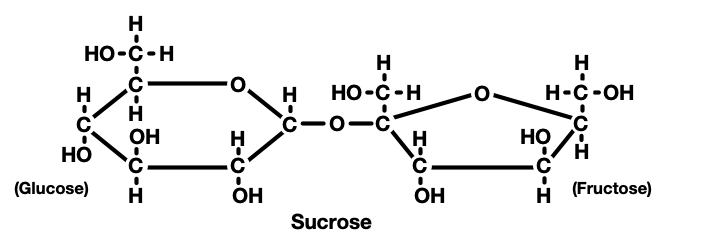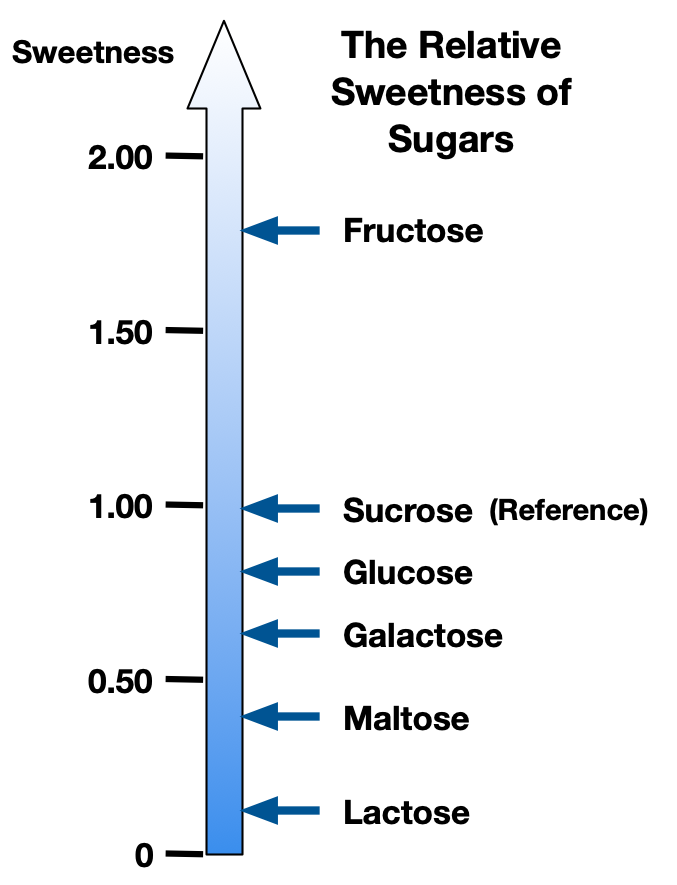Sugars and Starch
 Sugars are carbon-based molecules with bonds to hydrogen and oxygen in various combinations, and can be in rings or chains. The most important sugar for human biology is glucose, a 6-carbon compound monosaccharide, and this is the commonest form that sugar is found in the body. Fructose, also a 6-carbon compound, is the other common monosaccharide found in nature, with the difference being the arrangement of the carbon atoms relative to the covalent oxygen bond. Fructose is found predominantly in fruits and artificially manufactured syrups like corn syrup. Both of these sugars in the blood stimulate secretion of insulin from the pancreas.
Sugars are carbon-based molecules with bonds to hydrogen and oxygen in various combinations, and can be in rings or chains. The most important sugar for human biology is glucose, a 6-carbon compound monosaccharide, and this is the commonest form that sugar is found in the body. Fructose, also a 6-carbon compound, is the other common monosaccharide found in nature, with the difference being the arrangement of the carbon atoms relative to the covalent oxygen bond. Fructose is found predominantly in fruits and artificially manufactured syrups like corn syrup. Both of these sugars in the blood stimulate secretion of insulin from the pancreas.

These sugars are most commonly eaten in the form of sucrose (granular sugar/table sugar) which is a disaccharide consisting of one glucose and one fructose molecule bound together. It is found in, and extracted from sugar cane, sugar beets, and also in dates and honey. It is digested into glucose and fructose in the gut.

There are a number of other common sugars. Galactose, another 6-carbon monosaccharide, less stable than glucose and not usually found on it’s own. Galactose is most commonly found combined with glucose in lactose, a disaccharide found in milk. Maltose (malt sugar) is a disaccharide of two glucose molecules, and is the sugar produced by germinating grains used in the production of many drinks such as beer, whisky and malt flavoured milks.
 On this scale, the common artificial sweetener aspartamine (NutraSweet, Equal, Canderel) and the non-saccharide sweetener Steviol glycoside (Stevia) are 250 and 300 respectively.
On this scale, the common artificial sweetener aspartamine (NutraSweet, Equal, Canderel) and the non-saccharide sweetener Steviol glycoside (Stevia) are 250 and 300 respectively.
Starches are polysaccharides, simply long chains of glucose monosaccharides in the form of amylose or amylopectin with a the variation of structure, length and combinations giving the different properties of the different types of starch. Uncooked, starch is insoluble and so not digested as such, but fermented by the gut bacteria (microbiome) into short-chain fatty acids which are then absorbed by the gut. Once cooked, starch can be digested easily by amylase enzymes and absorbed as glucose. Highly processed foods tend to have more starch available for digestion as well as high levels of sugar.

Further Reading:
Wikipedia - Sugar
https://en.wikipedia.org/wiki/Sugar
Wikipedia - Glucose
https://en.wikipedia.org/wiki/Glucose
Wikipedia - Starch
https://en.wikipedia.org/wiki/Starch
Contact me

 What is a Low Carb Diet
What is a Low Carb Diet